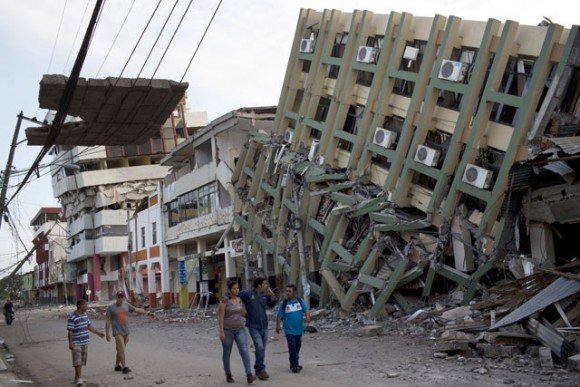Earthquake during El Niño led to rapid spead of
Zika epidemic
Health
care became dysfunctional; a harbinger of natural disasters
on a warmer Earth
|
 |
Nearly seven thousand
persons became infected with the Zika virus soon
after a large (magnitude 7.8) earthquake ravaged coastal
Ecuador in 2016. A Latin American team of scientists led
by Cecilia Sorensen, MD at the University of Colorado, conclude that a strong El Niño at the time combined
with the devastated infrastructure and a breakdown of social
structures to propel a widespread epidemic of Zika virus
(citation 1). The quake and the epidemic
coincided with a strong El Niño, a natural climate
anomaly that brings unusually warm and humid air and heavy
rainfall to the Pacific coast of South America. The “steam-bath”
atmosphere greatly accelerated the spread of Zika.
The
quake killed 660 people, displaced 9,700 people, damaged
9750 buildings, and put 720,000 people in need of humanitarian
assistance (2). It savaged the health
care and sanitation infrastructure, and forced people to
massively migrate into the cities (3).
(continues, below
left)
|
| El
Niño and its opposite, La Niña, together are
a natural climate variation that appears from time to time
over the last few thousands of years. Each time the local
weather/ seasonal climate are altered anywhere from a few
months to two years. On the west coast of South America,
El Niño brings high temperatures and humidity, and
rainfall well above normal. Whether or not a climate variation
is natural (an “unnatural” variation might be one caused
by human influences), the different weather conditions can
promote illness or make it difficult for a society to recover
from a natural disaster. (The plight of Puerto
Rico after hurricane Maria breezed through in September
2017 comes to mind.)
The
quake hit Ecuador only three months after the Zika virus
arrived in there in 2016, and El Niño was already
in progress. Mosquitoes, specifically the species Aedes
aegypti, transmit the Zika virus from person to person.
This same mosquito also carries the viruses that sicken
people with Dengue fever and Chikungunya fever. |
|
Sorensen's
team asserts that the “social vulnerability” of that region
made the health crisis unmanageable. The Intergovernmental
Panel on Climate Change (IPCC) defines social vulnerability
as the degree that a country cannot adapt to any external
change by altering its practices to offset potential damages.
In Ecuador, poor housing, the lack of piped water in homes,
and the marginal health care system allowed the mosquito
population to explode and spread the Zika virus quickly.
The bar graph at the right shows how quickly the illness
spread: from zero to ten cases cases before the quake,
to 300 cases ten weeks later. After the quake, people
slept outdoors where they felt safe but were exposed to
mosquito bites. With no running water piped into their
homes, people stored water in open cisterns where mosquito
larvae breed.
The
short-term climate conditions that El Niño ushered
in -- warmer temperatures at night, high humidity, and
heavy rainfall – fostered an explosion of mosquitoes.
Health officials had already blamed such conditions for
the rapid spread of Dengue fever by the same species of
mosquito. Because there were always more cases of Dengue
fever than of Zika, the health of the population and the
ability of the health care system to deal with it were
already strained by the Dengue fever epidemic.
|
Above: The confirmed number of cases
of Zika in Ecuador, for every week in 2016 and part of 2017.The
yellow circle marks the week of the earthquake in April
2016. (Data from Ecuadorian Ministry of Public Health.) |
Sorenson
does not attribute the spread of Zika to global climate
change. The anomalous weather during El Niño is
temporary and natural. However, she points out that global
climate is currently taking a direction toward warmer
and wetter conditions that are known to boost the spread
of infectious diseases.
Areas that are already stressed by short-term climate
changes like El Niño can be sent over the edge
by a natural catastrophe. The bottom line is that we would
be wise to prepare in advance for a health crisis when
a natural disaster strikes during anomalous climatic conditions,
especially in a region “socially vulnerable” to disasters.
When social structures like the police, emergency responders,
and the supply of water and food broke down in Ecuador,
a health crisis spiraled out of control. In our future
warmer climate on Earth, extreme weather, especially extreme
rainfall, are predicted to become more frequent. What
would the consequences be? Serious humanitarian crises
after natural disasters.
The authors recommend practices for society to prepare
for a difficult future in health care. They encompass
greater cooperation between sectors of society that deal
with disasters: the health care industry, the government,
the research enterprise, and the emergency response folks.
|
|
| CITATIONS:
1.
“Climate
Variability,Vulnerability, and Natural Disasters: A
Case Study of Zika Virus in Manabi, Ecuador Following the
2016 Earthquake” by Cecilia J. Sorensen , M J. Borbor-Cordova,
E. Calvello-Hynes, A Diaz, J. Lemery, and A. Stewart-Ibarra.
GeoHealth, vol. 1.
(Early View Article published online before inclusion
in a journal issue) –------ available with open access at:
https://doi.org/10.1002/2017GH000104.
2. Pan American Health Organization (2016): “The Earthquake
in Ecuador: Significant damage to health facilities; emergency
medical teams deployed.” Disasters, World Health Organization/Pan
American Health Organization, June 2016, vol. 121,
1-3.
3.
United States Agency for International Development (USAID,
2016): “Ecuador
- Earthquake.” Fact sheet #5, Fiscal year 2016.
| |
|

